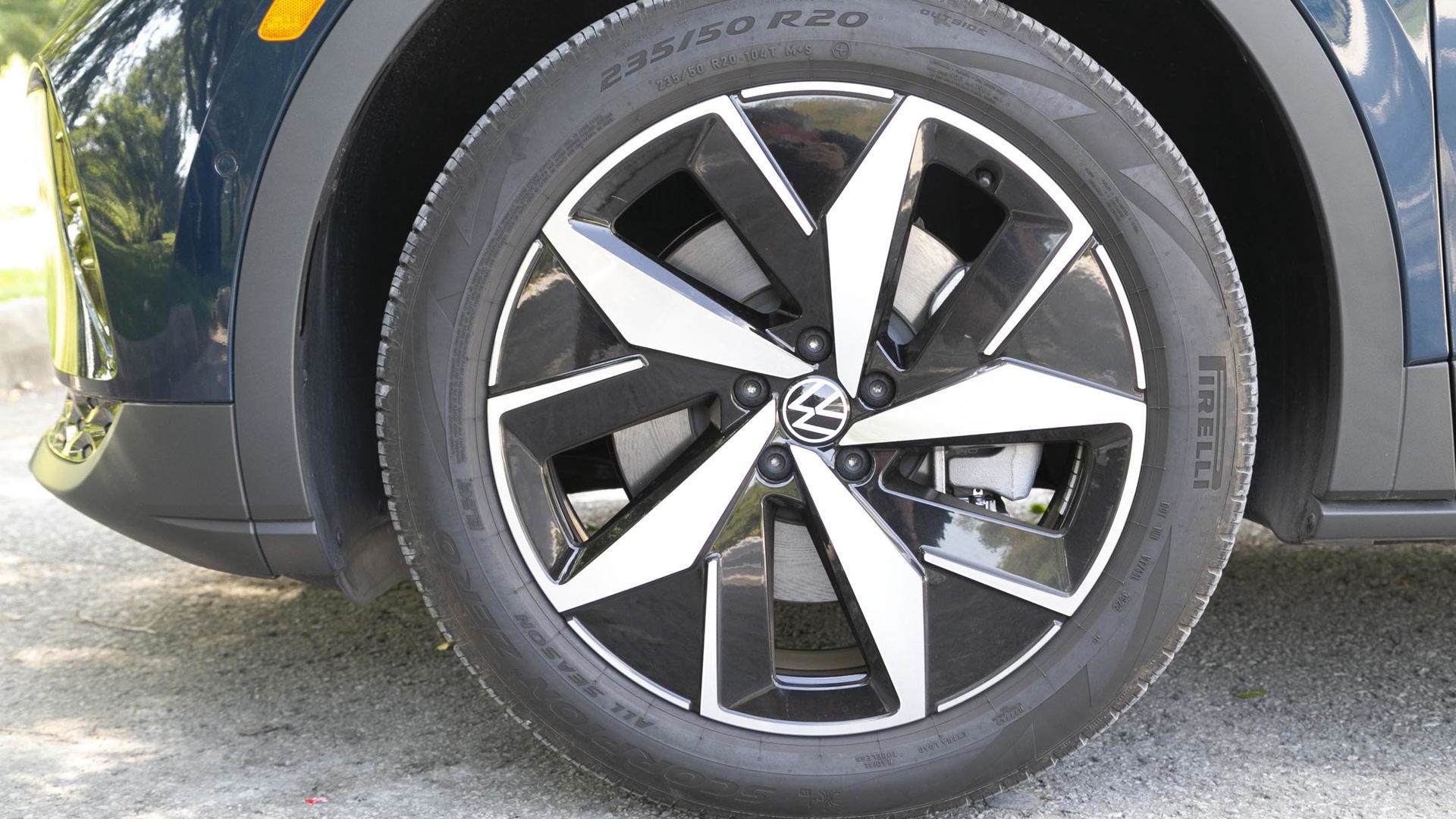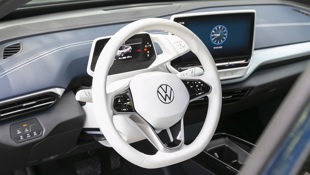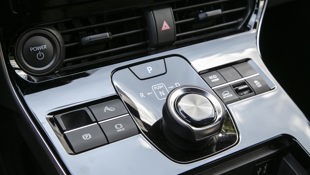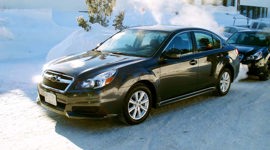Comparison Data
|
2023 Toyota bZ4X XLE AWD
|
2023 Volkswagen ID.4 Pro AWD
|
|---|---|
|
Engine Displacement
160 kW motor, 72.8 kWh battery
|
220 kW motor, 82 kWh battery
|
|
Engine Cylinders
Dual-motor electric
|
Dual-motor electric
|
|
Peak Horsepower
214 hp
|
295 hp
|
|
Peak Torque
248 lb-ft
|
339 lb-ft
|
|
Fuel Economy
2.1 / 2.5 / 2.3 Le/100 km, 18.4 / 22.3 / 20.1 kWh/100 km cty/hwy/cmb; 367 km est. range
|
2.3 / 2.5 / 2.4 Le/100 km, 20.1 / 22.6 / 21.2 kWh/100 km cty/hwy/cmb; 410 km est. range
|
|
Cargo Space
784 L
|
858 L
|
|
Base Price
$54,990
|
$55,495
|
|
A/C Tax
$100
|
$100
|
|
Destination Fee
$1,930
|
$2,050
|
|
Price as Tested
$58,120
|
$64,095
|
|
Optional Equipment
$1,100 – Two-tone XLE AWD, $1,100
|
$6,450 – Statement Package, $4,200; Panoramic Glass Roof, $1,250; 20” wheels, $1,000
|
Electrification is becoming increasingly prolific, with an ever-broadening spectrum of machines getting big battery packs in their bellies to help satisfy buyer demand for lower fuel costs and bigger environmental benefits.
Volkswagen has rebounded from the Dieselgate scandal with an electrified lineup that’s expanding slowly – at least in this part of the world. The previous e-Golf was a fine around-town runabout, but the ID.4 is the first ground-up electric vehicle (EV) developed by the automaker that’s offered in North America. And while it didn’t do a dramatic cannonball into the EV pool the way Hyundai’s Ioniq 5 or Kia’s EV6 both did, it has managed to impress us as a solid effort.
Meanwhile, Toyota has been a leader in hybrid technology for decades, believing hybrids are the smarter choice compared to EVs; but the need for an entirely emissions-free entry has led to the arrival of the 2023 Toyota bZ4X. And after some initial teething problems, it appears to be a reasonable alternative to the 2023 Volkswagen ID.4. That’s why we rounded up all-wheel-drive (AWD) versions of both to see how they stack up.
Fuel Economy
Both of these EVs happen to deliver the goods when it comes to fuel economy; however, you may prefer one or the other depending on whether you favour efficiency or overall range.
With a combination of highway and city driving, the official government rating for the ID.4 AWD is 21.2 kWh/100 km. This is very competitive with the Hyundai Ioniq 5 and Kia EV6 (splitting the two), but is marginally worse than Toyota’s figure of 20.1 kWh/100 km. This means the Toyota’s calculated annual fuel cost is $603 versus the Volkswagen’s $636. Skip a few Starbucks trips and you’ll make up the difference.
A bigger factor is the Toyota’s modest range of 367 km versus the Volkswagen’s 410 km. While a 43-km deficit may not seem like a big deal, it could be one more round-trip commute without plugging in, not to mention fewer charging stops on a road trip. We also found it easy to surpass the ID.4’s estimated range, even with unseasonably hot and humid temperatures prompting us to blast the air conditioning throughout this test.
Also, of note, the peak charge rate for the ID.4 is a decent 170 kW that, while still slow compared to its Hyundai and Kia competitors, is notably better than the bZ4X’s peak rate of 100 kW.
Toyota bZ4X: 9/10; Volkswagen ID.4: 9.5/10
Power
Both of these testers use separate electric motors for their front and rear wheels, with traction at all four corners as a result. (Opting for one less motor means front-wheel drive for the Toyota and rear-wheel drive for the Volkswagen.) Beyond the ability to get torque down regardless of weather and road conditions, the all-electric AWD systems also help whisk both the bZ4X and ID.4 away from a standstill with gusto. Around town, the benefit of the instantaneous nature of the torque delivery from electric motors means these two feel fairly well-matched while also being lively enough to stay ahead of most of their gas-powered counterparts.
When getting up to higher speeds on a highway on-ramp, or when looking to snap off a quick pass of slower traffic, the 214-hp Toyota runs out of steam in short order, while the Volkswagen’s 295 hp give it some notable extra shove. More importantly, the ID.4 has 339 lb-ft of torque – 91 more than the bZ4X’s meagre 248 lb-ft.
Toyota bZ4X: 7/10; Volkswagen ID.4: 8/10
Driving Feel
The Volkswagen may be more powerful, but it’s also heavier than the Toyota, so its acceleration advantage isn’t quite as vast as the power numbers might suggest. Plus, all that mass can be felt when turning and braking, too. The ID.4 feels solid and its steering requires more effort than the bZ4X’s.
The bZ4X reacts to driver inputs in a linear and more familiar way than the ID.4, which we found requires a bit of getting used to in order to be smooth with throttle and steering inputs. Buyers tentatively stepping into a full EV may find the bZ4X more familiar and easier to drive than the ID.4. Both offer variable rates of regenerative braking, but neither will allow a true one-pedal driving experience by bringing the machine to a full stop and holding it until the throttle is pressed again.
Toyota bZ4X: 7.5/10; Volkswagen ID.4: 7/10
Comfort
The Volkswagen’s Euro-firm suspension settings and larger 20-inch wheels with more aggressive tires do little to improve its handling while also diminishing its comfort. What’s more, while one of the best attributes of an EV is its whisper-quiet cruising capability, the Volkswagen had a surprisingly loud fan noise not related to the HVAC system, perhaps to help keep the battery pack cool. What’s more, this tester’s climate system emitted a funky, musty smell that permeated the cabin after a few humid days of air conditioner use.
The bZ4X rides more smoothly than the ID.4, and it’s quieter, too. Seating comfort in both is good with modest bolstering, and firm support in all the right spots.
Toyota bZ4X: 8/10; Volkswagen ID.4: 7/10
Practicality
The Volkswagen’s rear seat is much roomier than the Toyota’s comparatively tight confines. The ID.4’s cargo hold, at 858 L, is larger than the bZ4X’s 784-L space; and while Toyota doesn’t list any towing capability, Volkswagen rates its EV at 1,224 kg (2,698 lb) – comparable to other small crossovers. Bizarrely, the bZ4X doesn’t have a traditional glovebox, leaving only the open space below the centre console for the owner’s manual.
Toyota bZ4X: 7/10; Volkswagen ID.4: 8/10
User Friendliness
While both EVs provide great outward visibility, the Volkswagen falls short of the Toyota in its cockpit layout and controls. In a move to make the ID.4’s cabin modern and high-tech (not to mention to cut costs), Volkswagen opted to minimize physical controls, instead relying on the 12-inch touchscreen for many functions. The extensive use of haptic panels for temperature and volume controls, plus all the buttons on the steering wheel, might look slick, but it’s all tedious to use and requires more of the driver’s attention than traditional buttons. Volkswagen’s voice controls work pretty well and can eliminate the need for fussing with the haptic panels a lot of the time, but the biggest head-scratcher is the decision to put only two window buttons up front, with a third button to switch between front and rear controls.
The bZ4X utilizes a lot of physical buttons, many of which will be familiar to those who’ve had Toyotas in recent years; and while there’s less dependence on the 12.3-inch touchscreen for secondary controls, the climate controls are operated via touch panels, and the volume controls are a pair of tiny buttons beneath the screen. Surely, a little volume knob could’ve fit somewhere instead.
The Toyota’s thick-rimmed steering wheel feels good in-hand and wears 15 buttons, plus a four-direction touchpad, putting a number of key functions at the driver’s thumbs. The elevated perch for the instrument panel might look odd at first, but in practice, most drivers seated in a sensible position will have no trouble viewing all the displayed information. And since it’s placed so high, it helps keep eyes on the road while eliminating the need for a separate head-up display.
Toyota bZ4X: 9/10; Volkswagen ID.4: 7/10
Features
Both testers came equipped with heated – but not ventilated – seats, fixed-glass panoramic sunroofs, and multi-speaker sound systems. Other features include wireless smartphone connectivity, and four USB-C ports. While neither came with real leather upholstery, the ID.4’s fake stuff felt richer and was specced with a rudimentary massage feature. With the optional Tech package, the Toyota can be similarly equipped, minus the massagers.
Toyota bZ4X: 7.5/10; Volkswagen ID.4: 8/10
Safety
Volkswagen and Toyota have both integrated full advanced safety suites in these EVs. Adaptive cruise control, blind-spot monitoring, pedestrian and cyclist detection, autonomous emergency braking, and lane-keeping assistance are all included.
The Insurance Institute for Highway Safety (IIHS) rates the ID.4 a Top Safety Pick+ for 2023, while the bZ4X misses out on any honour thanks to the headlights included on lesser trims. The United States National Highway Traffic Safety Administration (NHTSA) has also bestowed a five-star rating on the Volkswagen, while the agency had not yet tested the Toyota at the time of this writing.
Toyota bZ4X: 8/10; Volkswagen ID.4: 9/10
Styling
Even though styling is highly subjective, it can weigh considerably on a buyer’s decision. Toyota’s bZ4X has been styled to be distinctive, but while its sharp creases may not be to everyone’s taste, the oversized black fender panels can draw strong responses from fellow motorists, some of whom made no attempt to hide their distaste for the Toyota’s appearance during this test.
Inside, the bZ4X is finished in cheaper-looking materials, but if past Toyotas are anything to go by, they should hold up well over time. Conversely, our ID.4 tester’s interior looked fresh and modern, but white seats and a white steering wheel seem like huge challenges to keep looking crisp and clean.
The Volkswagen’s exterior, especially finished in a lovely metallic blue paint, is handsome if entirely unoffensive. In fact, it’s probably the most innocuously styled EV on the road, looking like a well-proportioned midsize crossover that doesn’t make a big deal about the way it’s powered.
Toyota bZ4X: 6/10; Volkswagen ID.4: 8/10
Value
Toyota and Volkswagen both offer their EVs in lower-cost two-wheel-drive versions, but our top-trim AWD testers start within $500 of each other. At $54,990, the 2023 Toyota bZ4X XLE AWD is the better value in terms of feature count, offering the panoramic roof as standard fare compared to the $55,495 for the 2023 Volkswagen ID.4 Pro AWD. That the Toyota is also the more miserly machine, however, for those seeking a more spacious EV, or one with more power and range, the nominal price increase to get the Volkswagen seems worthwhile.
Toyota bZ4X: 8/10; Volkswagen ID.4: 8/10
The Verdict
Although Toyota’s bZ4X offers good efficiency and an attractive price for an AWD EV, its relative lack of power and range compared to the ID.4 make it a less appealing choice. For those keen on Toyota’s reputation for quality, a plug-in hybrid Prius Prime may actually be a better option, offering much of the usability of an EV with the added benefit of an efficient gas engine to eliminate any latent range anxiety. Plus, the Prius Prime is genuinely attractive, which cannot be said about the bZ4X.
Between these two, Volkswagen’s ID.4 Pro AWD is the more compelling choice, offering greater practicality, nicer finishes, more power, and, most notably, more usable range – all for almost the same cost as the Toyota.






























































